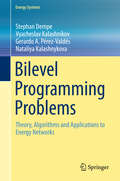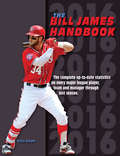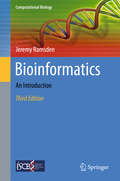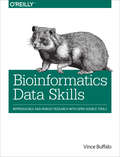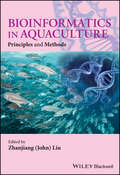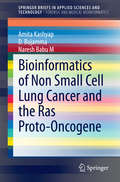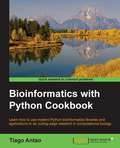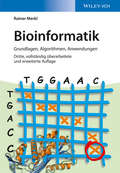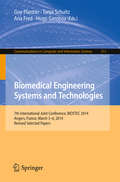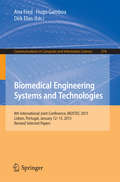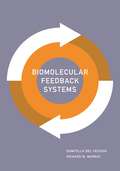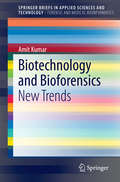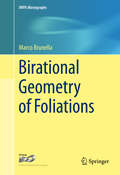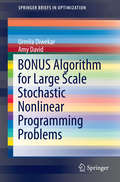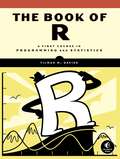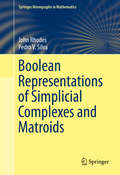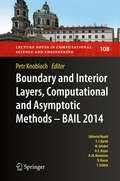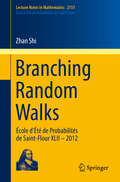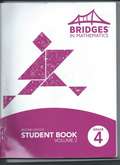- Table View
- List View
Big Ideas Math Course 2 Accelerated: A Common Core Curriculum California Pupil Edition
by Ron Larson Laurie BoswellThe Big Ideas Math program balances conceptual understanding with procedural fluency. Embedded Mathematical Practices in grade-level content promote a greater understanding of how mathematical concepts are connected to each other and to real-life, helping turn mathematical learning into an engaging and meaningful way to see and explore the real world.
Bilevel Programming Problems: Theory, Algorithms and Applications to Energy Networks (Energy Systems)
by Stephan Dempe Vyacheslav Kalashnikov Gerardo A. Pérez-Valdés Nataliya KalashnykovaThis book describes recent theoretical findings relevant to bilevel programming in general, and in mixed-integer bilevel programming in particular. It describes recent applications in energy problems, such as the stochastic bilevel optimization approaches used in the natural gas industry. New algorithms for solving linear and mixed-integer bilevel programming problems are presented and explained.
Bill James Handbook 2015
by Bill JamesThe first, best, most complete annual baseball reference guide available. Full of exclusive stats, this book is the most comprehensive resource on every hit, pitch, and catch in Major League Baseball's 2014 season--and includes player projections for 2015.
Bioinformatics: An Introduction (Computational Biology #21)
by Jeremy RamsdenThis comprehensive textbook presents a self-contained guide to bioinformatics, defined in its broadest sense as the application of information science to biology. Thoroughly updated and greatly expanded, this third edition now includes material on the growing array of "-omics"; covering metagenomics, toxicogenomics, glycomics, lipidomics, microbiomics and phenomics. New chapters have also been added on ecosystems management and the nervous system. Emphasis is placed on providing both a firm grounding in the core concepts and a clear overview of the complete field of bioinformatics. Features: explains the fundamentals of information science relevant to biology; covers both organismal (ontogeny and phylogeny, as well as genome structure) and molecular aspects; examines the most important practical applications of bioinformatics, providing detailed descriptions of both the experimental process and the data analysis; provides a varied selection of problems throughout the book, to stimulate further thinking.
Bioinformatics Data Skills
by Vince BuffaloLearn the data skills necessary for turning large sequencing datasets into reproducible and robust biological findings. With this practical guide, you'll learn how to use freely available open source tools to extract meaning from large complex biological data sets.At no other point in human history has our ability to understand life's complexities been so dependent on our skills to work with and analyze data. This intermediate-level book teaches the general computational and data skills you need to analyze biological data. If you have experience with a scripting language like Python, you're ready to get started.Go from handling small problems with messy scripts to tackling large problems with clever methods and toolsProcess bioinformatics data with powerful Unix pipelines and data toolsLearn how to use exploratory data analysis techniques in the R languageUse efficient methods to work with genomic range data and range operationsWork with common genomics data file formats like FASTA, FASTQ, SAM, and BAMManage your bioinformatics project with the Git version control systemTackle tedious data processing tasks with with Bash scripts and Makefiles
Bioinformatics Data Skills: Reproducible and Robust Research with Open Source Tools
by Vince BuffaloLearn the data skills necessary for turning large sequencing datasets into reproducible and robust biological findings. With this practical guide, you’ll learn how to use freely available open source tools to extract meaning from large complex biological data sets.At no other point in human history has our ability to understand life’s complexities been so dependent on our skills to work with and analyze data. This intermediate-level book teaches the general computational and data skills you need to analyze biological data. If you have experience with a scripting language like Python, you’re ready to get started.Go from handling small problems with messy scripts to tackling large problems with clever methods and toolsProcess bioinformatics data with powerful Unix pipelines and data toolsLearn how to use exploratory data analysis techniques in the R languageUse efficient methods to work with genomic range data and range operationsWork with common genomics data file formats like FASTA, FASTQ, SAM, and BAMManage your bioinformatics project with the Git version control systemTackle tedious data processing tasks with with Bash scripts and Makefiles
Bioinformatics in Aquaculture: Principles and Methods
by Zhanjiang John LiuBioinformatics derives knowledge from computer analysis of biological data. In particular, genomic and transcriptomic datasets are processed, analysed and, whenever possible, associated with experimental results from various sources, to draw structural, organizational, and functional information relevant to biology. Research in bioinformatics includes method development for storage, retrieval, and analysis of the data. Bioinformatics in Aquaculture provides the most up to date reviews of next generation sequencing technologies, their applications in aquaculture, and principles and methodologies for the analysis of genomic and transcriptomic large datasets using bioinformatic methods, algorithm, and databases. The book is unique in providing guidance for the best software packages suitable for various analysis, providing detailed examples of using bioinformatic software and command lines in the context of real world experiments. This book is a vital tool for all those working in genomics, molecular biology, biochemistry and genetics related to aquaculture, and computational and biological sciences.
Bioinformatics of Non Small Cell Lung Cancer and the Ras Proto-Oncogene (SpringerBriefs in Applied Sciences and Technology)
by Amita Kashyap D. Bujamma Naresh Babu MCancer is initiated by activation of oncogenes or inactivation of tumor suppressor genes. Mutations in the K-ras proto-oncogene are responsible for 10-30% of adenocarcinomas. Clinical Findings point to a wide variety of other cancers contributing to lung cancer incidence. Such a scenario makes identification of lung cancer difficult and thus identifying its mechanisms can contribute to the society. Identifying unique conserved patterns common to contributing proto-oncogenes may further be a boon to Pharmacogenomics and pharmacoinformatics. This calls for ab initio/de novo drug discovery that in turn will require a comprehensive in silico approach of Sequence, Domain, Phylogenetic and Structural analysis of the receptors, ligand screening and optimization and detailed Docking studies. This brief involves extensive role of the RAS subfamily that includes a set of proteins, which cause an over expression of cancer-causing genes like M-ras and initiate tumour formation in lungs. SNP Studies and Structure based drug discovery will also be undertaken.
Bioinformatics with Python Cookbook
by Tiago AntaoIf you have intermediate-level knowledge of Python and are well aware of the main research and vocabulary in your bioinformatics topic of interest, this book will help you develop your knowledge further.
Bioinformatik
by Rainer MerklDie zweite Auflage dieses erfolgreichen Lehrbuchs ist vollständig überarbeitet und in großen Teilen erweitert. Insbesondere wurde die Behandlung der Genomdatenanalyse deutlich vertieft und es wurden Kapitel über maschinelles Lernen, bayessche Netzwerke sowie Protein- und Enzymdesigns und über die Auswertung von Microarrays eingeführt. Außerdem steht dem Leser jetzt eine attraktive Webseite mit Zusatzmaterial und Fragen zum Stoff zur Verfügung. Webseite mit Zusatzmaterial und Fragen: WWW. WILEY-VCH. DE/HOME/BIOINFORMATIK
Biomedical Engineering Systems and Technologies: 7th International Joint Conference, BIOSTEC 2014, Angers, France, March 3-6, 2014, Revised Selected Papers (Communications in Computer and Information Science #511)
by Ana Fred Hugo Gamboa Guy Plantier Tanja SchultzThis book constitutes the thoroughly refereed post-conference proceedings of the 7th International Joint Conference on Biomedical Engineering Systems and Technologies, BIOSTEC 2014, held in Angers, France, in March 2014. The 25 revised full papers presented were carefully reviewed and selected from a total of 362 submissions. The papers cover a wide range of topics and are organized in topical sections on biomedical electronics and devices; bioimaging; bioinformatics models, methods and algorithms; bio-inspired systems and signal processing; health informatics.
Biomedical Engineering Systems and Technologies: 8th International Joint Conference, BIOSTEC 2015, Lisbon, Portugal, January 12-15, 2015, Revised Selected Papers (Communications in Computer and Information Science #574)
by Ana Fred Hugo Gamboa Dirk EliasThis book constitutes the thoroughly refereedpost-conference proceedings of the 8th International Joint Conference onBiomedical Engineering Systems and Technologies, BIOSTEC 2015, held in Lisbon,Portugal, in January 2015. The 27 revised full papers presented together with aninvited paper were carefully reviewed and selected from a total of 375submissions. The papers cover a wide range of topics and are organized in fourgeneral topical sections on biomedical electronics and devices;bioimaging; bioinformatics models,methods and algorithms; bio-inspired systems and signalprocessing; health informatics.
Biomolecular Feedback Systems
by Domitilla Del Vecchio Richard MurrayThis book provides an accessible introduction to the principles and tools for modeling, analyzing, and synthesizing biomolecular systems. It begins with modeling tools such as reaction-rate equations, reduced-order models, stochastic models, and specific models of important core processes. It then describes in detail the control and dynamical systems tools used to analyze these models. These include tools for analyzing stability of equilibria, limit cycles, robustness, and parameter uncertainty. Modeling and analysis techniques are then applied to design examples from both natural systems and synthetic biomolecular circuits. In addition, this comprehensive book addresses the problem of modular composition of synthetic circuits, the tools for analyzing the extent of modularity, and the design techniques for ensuring modular behavior. It also looks at design trade-offs, focusing on perturbations due to noise and competition for shared cellular resources.Featuring numerous exercises and illustrations throughout, Biomolecular Feedback Systems is the ideal textbook for advanced undergraduates and graduate students. For researchers, it can also serve as a self-contained reference on the feedback control techniques that can be applied to biomolecular systems.Provides a user-friendly introduction to essential concepts, tools, and applicationsCovers the most commonly used modeling methodsAddresses the modular design problem for biomolecular systemsUses design examples from both natural systems and synthetic circuitsSolutions manual (available only to professors at press.princeton.edu)An online illustration package is available to professors at press.princeton.edu
A Biostatistics Toolbox for Data Analysis
by Steve SelvinThis sophisticated package of statistical methods is for advanced master's (MPH) and PhD students in public health and epidemiology who are involved in the analysis of data. It makes the link from statistical theory to data analysis, focusing on the methods and data types most common in public health and related fields. Like most toolboxes, the statistical tools in this book are organized into sections with similar objectives. Unlike most toolboxes, however, these tools are accompanied by complete instructions, explanations, detailed examples, and advice on relevant issues and potential pitfalls - conveying skills, intuition, and experience. The only prerequisite is a first-year statistics course and familiarity with a computing package such as R, Stata, SPSS, or SAS. Though the book is not tied to a particular computing language, its figures and analyses were all created using R. Relevant R code, data sets, and links to public data sets are available from www. cambridge. org/9781107113084.
Biotechnology and Bioforensics: New Trends (SpringerBriefs in Applied Sciences and Technology)
by Amit KumarThis Brief covers broad areas of Applied Biology specifically into the domains of Biotechnology/Biomedicine and Forensic Science. Chapters included here would also explain the role of bioinformatics in protein and gene characterization, modeling of the protein structure, survey related to the chromosomal effect on Human Disorders like Diabetes and Cardiac Problems. This Brief is full of Innovative Literature like Use of Microbes in Electricity Production, Brain connection to Type 2 Diabetes etc. Interesting issues in Forensic biology and the aspects of Bioforensics like STR profiling of exhumed bones makes this brief truly useful and informative for Researchers. It also includes the advancements and new ideologies in understanding crop improvements & crop quality. This Brief witnesses Innovative Research related to the Bio and Agri software development too which are capable of accelerating Insilico biological data analysis.
Birational Geometry of Foliations (IMPA Monographs #1)
by Marco BrunellaThe text presents the birational classification of holomorphic foliations of surfaces. It discusses at length the theory developed by L. G. Mendes, M. McQuillan and the author to study foliations of surfaces in the spirit of the classification of complex algebraic surfaces.
The Bloch-Kato Conjecture for the Riemann Zeta Function
by John Coates A. Raghuram Anupam Saikia R. SujathaThere are still many arithmetic mysteries surrounding the values of the Riemann zeta function at the odd positive integers greater than one. For example, the matter of their irrationality, let alone transcendence, remains largely unknown. However, by extending ideas of Garland, Borel proved that these values are related to the higher K-theory of the ring of integers. Shortly afterwards, Bloch and Kato proposed a Tamagawa number-type conjecture for these values, and showed that it would follow from a result in motivic cohomology which was unknown at the time. This vital result from motivic cohomology was subsequently proven by Huber, Kings, and Wildeshaus. Bringing together key results from K-theory, motivic cohomology, and Iwasawa theory, this book is the first to give a complete proof, accessible to graduate students, of the Bloch-Kato conjecture for odd positive integers. It includes a new account of the results from motivic cohomology by Huber and Kings.
BONUS Algorithm for Large Scale Stochastic Nonlinear Programming Problems (SpringerBriefs in Optimization)
by Urmila Diwekar Amy DavidThis book presents the details of the BONUS algorithm and its real world applications in areas like sensor placement in large scale drinking water networks, sensor placement in advanced power systems, water management in power systems, and capacity expansion of energy systems. A generalized method for stochastic nonlinear programming based on a sampling based approach for uncertainty analysis and statistical reweighting to obtain probability information is demonstrated in this book. Stochastic optimization problems are difficult to solve since they involve dealing with optimization and uncertainty loops. There are two fundamental approaches used to solve such problems. The first being the decomposition techniques and the second method identifies problem specific structures and transforms the problem into a deterministic nonlinear programming problem. These techniques have significant limitations on either the objective function type or the underlying distributions for the uncertain variables. Moreover, these methods assume that there are a small number of scenarios to be evaluated for calculation of the probabilistic objective function and constraints. This book begins to tackle these issues by describing a generalized method for stochastic nonlinear programming problems. This title is best suited for practitioners, researchers and students in engineering, operations research, and management science who desire a complete understanding of the BONUS algorithm and its applications to the real world.
The Book of R: A First Course in Programming and Statistics
by Tilman M. DaviesThe Book of R is a comprehensive, beginner-friendly guide to R, the world’s most popular programming language for statistical analysis. Even if you have no programming experience and little more than a grounding in the basics of mathematics, you’ll find everything you need to begin using R effectively for statistical analysis.You’ll start with the basics, like how to handle data and write simple programs, before moving on to more advanced topics, like producing statistical summaries of your data and performing statistical tests and modeling. You’ll even learn how to create impressive data visualizations with R’s basic graphics tools and contributed packages, like ggplot2 and ggvis, as well as interactive 3D visualizations using the rgl package.Dozens of hands-on exercises (with downloadable solutions) take you from theory to practice, as you learn:–The fundamentals of programming in R, including how to write data frames, create functions, and use variables, statements, and loops–Statistical concepts like exploratory data analysis, probabilities, hypothesis tests, and regression modeling, and how to execute them in R–How to access R’s thousands of functions, libraries, and data sets–How to draw valid and useful conclusions from your data–How to create publication-quality graphics of your resultsCombining detailed explanations with real-world examples and exercises, this book will provide you with a solid understanding of both statistics and the depth of R’s functionality. Make The Book of R your doorway into the growing world of data analysis.
Boolean Representations of Simplicial Complexes and Matroids (Springer Monographs in Mathematics)
by John Rhodes Pedro V. SilvaThis self-contained monograph explores a new theory centered around boolean representations of simplicial complexes leading to a new class of complexes featuring matroids as central to the theory. The book illustrates these new tools to study the classical theory of matroids as well as their important geometric connections. Moreover, many geometric and topological features of the theory of matroids find their counterparts in this extended context. Graduate students and researchers working in the areas of combinatorics, geometry, topology, algebra and lattice theory will find this monograph appealing due to the wide range of new problems raised by the theory. Combinatorialists will find this extension of the theory of matroids useful as it opens new lines of research within and beyond matroids. The geometric features and geometric/topological applications will appeal to geometers. Topologists who desire to perform algebraic topology computations will appreciate the algorithmic potential of boolean representable complexes.
Boundary and Interior Layers, Computational and Asymptotic Methods - BAIL 2014 (Lecture Notes in Computational Science and Engineering #108)
by Petr KnoblochThis volume offers contributions reflecting a selection of the lectures presented at the international conference BAIL 2014, which was held from 15th to 19th September 2014 at the Charles University in Prague, Czech Republic. These are devoted to the theoretical and/or numerical analysis of problems involving boundary and interior layers and methods for solving these problems numerically. The authors are both mathematicians (pure and applied) and engineers, and bring together a large number of interesting ideas. The wide variety of topics treated in the contributions provides an excellent overview of current research into the theory and numerical solution of problems involving boundary and interior layers.
Branching Random Walks: École d'Été de Probabilités de Saint-Flour XLII – 2012 (Lecture Notes in Mathematics #2151)
by Zhan ShiProviding an elementary introduction to branching random walks, the main focus of these lecture notes is on the asymptotic properties of one-dimensional discrete-time supercritical branching random walks, and in particular, on extreme positions in each generation, as well as the evolution of these positions over time. Starting with the simple case of Galton-Watson trees, the text primarily concentrates on exploiting, in various contexts, the spinal structure of branching random walks. The notes end with some applications to biased random walks on trees.
Bridges in Mathematics: Student Book, Volume 2
by The Math Learning CenterBridges in Mathematics is a standards-based K-5 curriculum that provides a unique blend of concept development and skills practice in the context of problem solving. It incorporates the Number Corner, a collection of daily skill-building activities for students.
Bridges in Mathematics, Grade 4: Student Book, Volumes 1 and 2
by The Math Learning CenterNIMAC-sourced textbook

